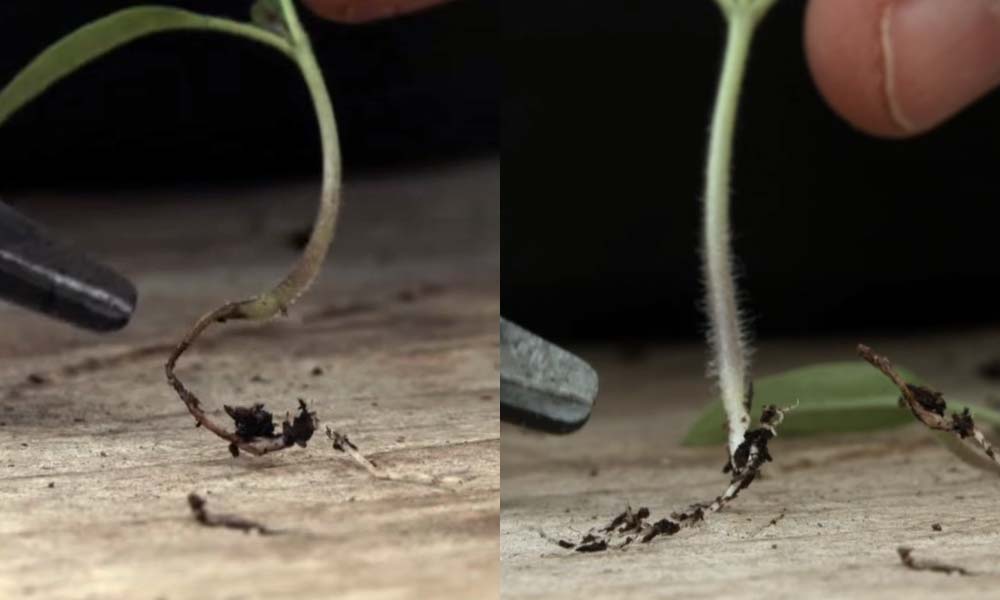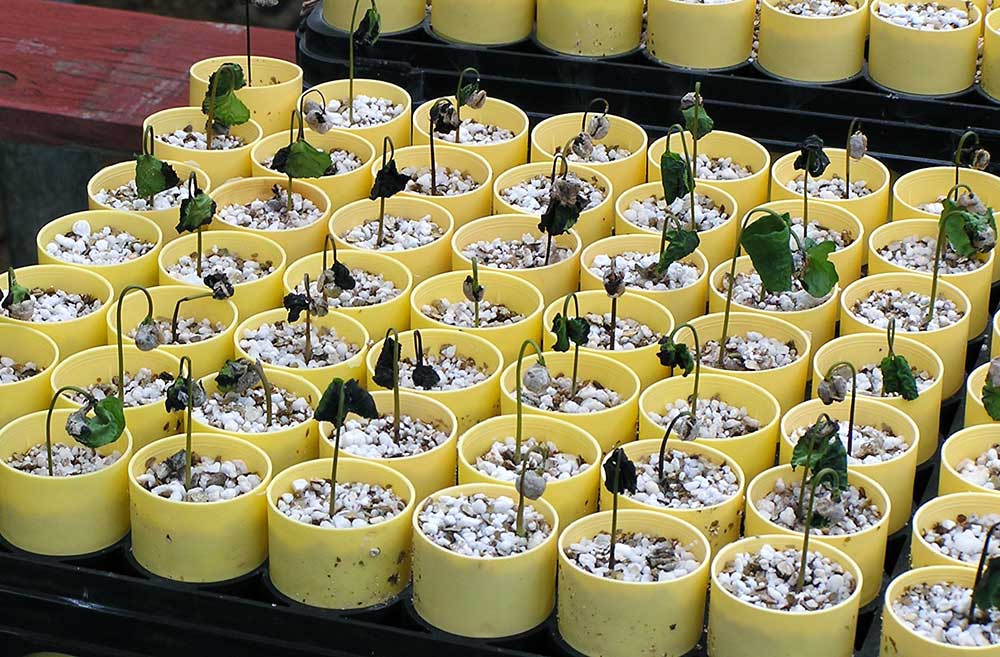“Damping off” is not so much a lone disease but a collection of diseases affecting thousands of plant species. While the causes vary, the result is the same—shortly after germination, seedlings are weakened, with some of them dying. Specific symptoms vary depending on the cause, but often the stems exhibit spots, lesions, thinning, and/or toughening of the stem. Occasionally, the roots of affected seedlings became truncated or rot away, and signs of mold growth are seen above the soil line.
The symptoms of damping off vary, but generally include stunted growth and rotting of plant tissues.
The most notable symptom of damping off is the rotting of plant tissues near the soil surface shortly after a seedling germinates. The first sign of this tissue degradation is the base of the stem softening and becoming damp (hence the name). As this occurs the stem will narrow, becoming tapered and threadlike, and may turn gray or brown. Often, the stem will collapse, folding over in the middle or near the soil line.
The same symptoms are seen in the first leaves—wilted, wet, mushy, and with a tan or brown coloration. Beneath the soil, roots are stunted, and have sunken brown spots, and may be rotten or even entirely absent. Inevitably, infected seedlings wither and die.

In some cases, seedlings may succumb and die immediately after germination, never managing to break through the soil surface. Instances where seedlings are infected and die before reaching the surface are sometimes referred to as “pre-emergence damping off,” while death after breaking the soil is called “post-emergence damping off.”
In conditions of high humidity, mold growth will be visible, with affected plants sprouting white fluffy, cobweb-like growths, often near the soil surface.
Damping off is strictly a disease of young plants. If plants survive germination, they will develop a resistance to the disease. In fact, damping off often occurs in patches, with affected seedlings on the boundaries of these patches dying immediately adjacent to healthy plants. However, plants may be attacked by the fungi but not develop damping off, instead exhibiting milder symptoms that may be missed, such as constriction of the stem near the soil line.

Damping off is caused by myriad species of soil-dwelling fungi and water molds.
Damping off is a consequence of infection by any of a number of soil-borne fungi and mold species, including but not limited to:
- Aphanomyces cochlioides
- Arthrinium sacchari
- Botrytis cinerea
- Fusarium commune
- Macrophomina phaseoli
- Phytophthora capsica
- Pythium torulosum
- Rhizoctonia solani
- Sclerotium rolfsii
But there are literally hundreds of species known to cause damping off, generally falling within the genuses Alternaria, Botrytis, Fusarium, Phytophthora, Pseudomonas, Pythium, and Rhizoctonia, with Pythium being a particularly common offender in the United States. Damping off occurs throughout the world, with causal species varying by region.
These fungal pathogens are practically unavoidable in outdoors soils. Greenhouses can eliminate the presence of these fungi through careful sanitation, but often experience outbreaks due to the introduction of contaminated soils, tools, or pots. Spores can be spread by the wind, or be carried by fungus gnats.
There is no treatment for plants suffering from damping off, but the causal organisms can be controlled with fungicides, implementation of proper drainage, and sanitation.
All fungal and water mold species which cause damping off favor moist soil conditions, especially when drainage is poor. Growers should ensure that fields drain properly, with no signs of standing water. The use of sprinklers, rather than surface irrigation, allows for better control of watering and reduces the presence of conditions favorable to damping off. Amending the soil through the addition of fir bark or peat moss can improve drainage. Avoid the use of green compost, as this encourages moist conditions. Be careful about applying excessive nitrogen fertilizer.
In addition, farmers should avoid planting seeds when soil temperatures are low, as this slows germination and growth. Once seedlings reach sufficient size, they are invulnerable to damping off, so this is essentially a race against time. Planting when weather is warm will ensure that seeds germinate and grow faster, allowing them to quickly pass through the period of vulnerability.
You may also opt to start seeds in a controlled environment in sterilized soil, and then transplant the seedlings to fields after they have grown large enough to resist damping off.
Seedlings infected with damping off cannot be treated and will inevitably die. The first response to signs of infection should be to remove and destroy all infected seedlings. Then sterilize all equipment which has been in contact with contaminated fields. Prior to the next planting, in the spring when weather is consistently sunny, soil solarization—applying clear tarps over affected fields for 4 to 6 weeks—is an effective method of reducing soil pathogen levels.
Many fungicides are also effective at reducing pathogen levels. However, avoid fungicide applications when seedlings are first sprouting, as exposure to fungicide can slow growth and make them more vulnerable to infection. You may also opt to coat seeds with fungicide prior to planting. If you have had issues with damping off, and wish to use a fungicide, it’s advisable that you send a plant tissue sample off for testing. Identifying the species of pathogen present in the soil will aid in selecting the most effective fungicidal treatment.
No two cases are the same. But ensuring proper nutrition goes a long way towards reducing the incidence and severity of damping off. Utilizing a preplant application of Fusion 360 Soil and Iota can replenish the nutritional value of soil and stimulate microbial activity, giving seeds and plants a more vigorous start. When working with nursery stock, growers can treat seedlings with a foliar spray solution containing Fusion 360 Foliar FG-31, Integrity 9.5% Calcium, and Integrity FG-Micros to boost plant physiological activity prior to transplanting. Balanced nutrition is a key part of any plant disease treatment and prevention solution.




